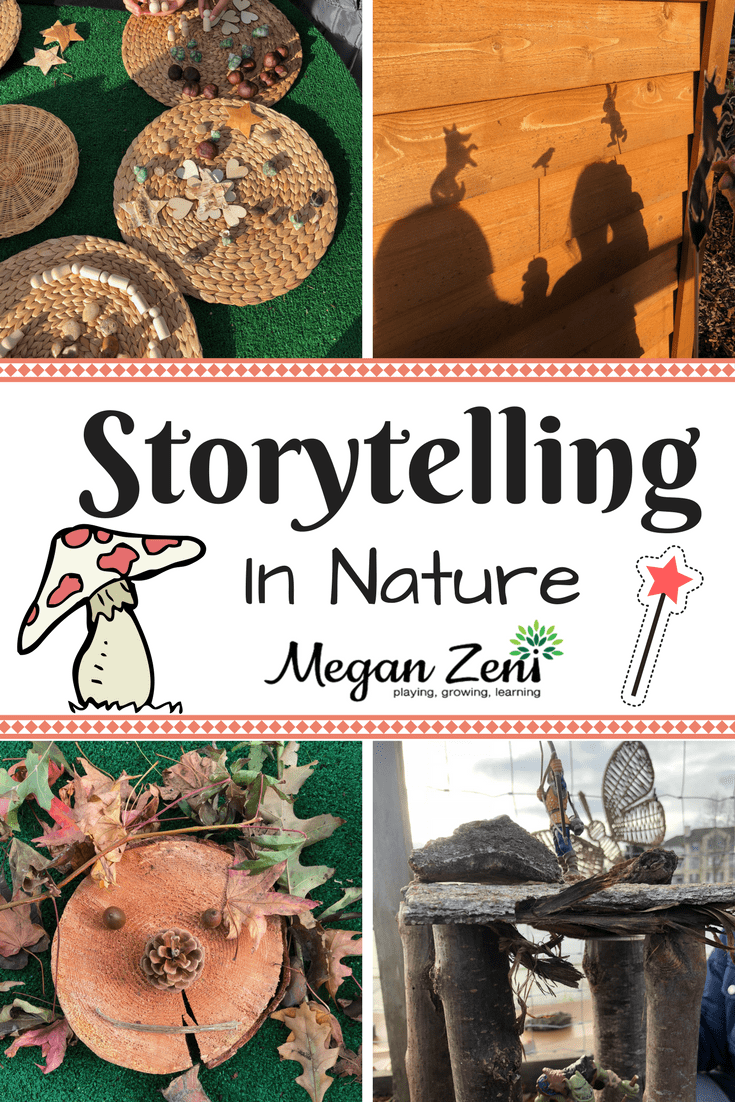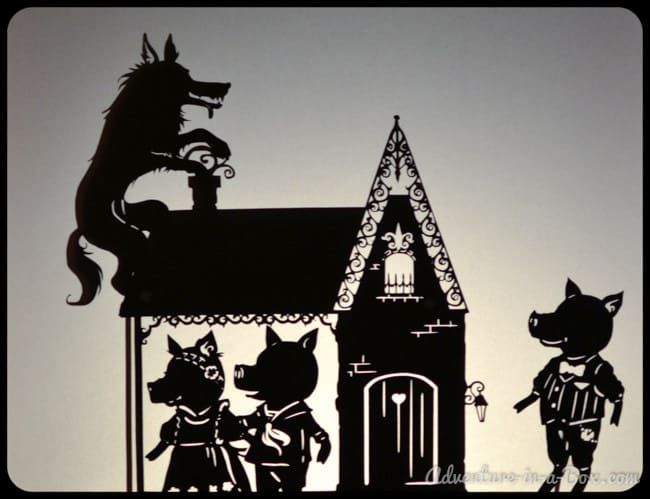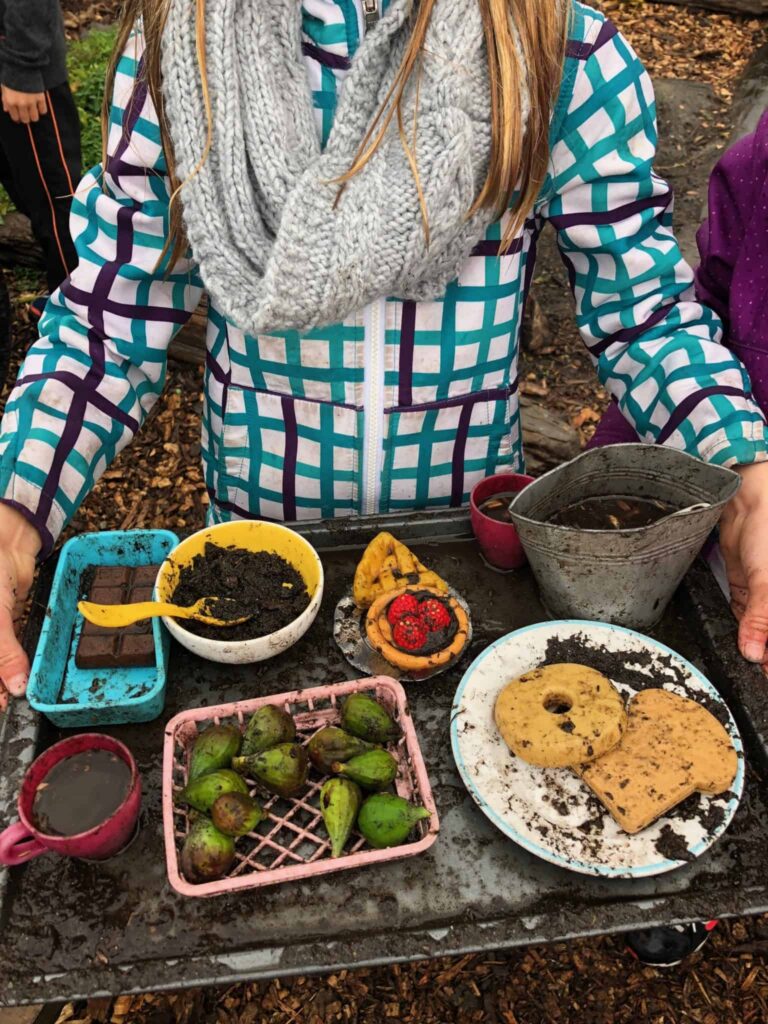- filed under: Literacy Outdoors, Loose Parts, Playful Learning Outdoors
Storytelling in Nature
Walking, working and playing in nature invites children’s imaginations to create stories that reflect their lived experiences, their wonders and their understandings of the world around them.
With children of all ages, using the natural world as a space for storytelling in nature is a manageable first step to the story writing process. By avoiding the dreaded pencil and paper brainstorming of ideas, storytelling in nature follows the Waldorf tradition of oral storytelling to ignite imaginative thinking, and support the ability to see a story in one’s own mind.
As a parent or teacher, the prep and requirements for success are uncomplicated. Simply prepare a space for oral story-telling, or guide your children on a walk through a natural area using the following ideas for inspiration!
Storytelling with Loose Parts
In my experience, there are high and low affordance materials that facilitate creative outdoor story telling. When using loose parts for story telling be thoughtful in what kind of story telling you want the children to engage in. Play experts will often refer to “affordances of play” by which they mean the multitude of ways a loose part can be used in play. If you want children to retell a familiar story, then using lower affordance materials are suitable. However, if you want children to be creative in their story telling, higher affordance materials are necessary.
Manufactured materials with faces on them, or prescribed characteristics like warrior or battle sets, have a lower affordance for play than a blank wooden peg doll or a stick, for example. Children’s play will be more creative and divergent if they invent the story using high affordance materials that allow for any material to become anything their imagination can conjure.
Loose Parts: Inspiring Play in Young Children is an excellent resource for anyone new to the concept and would like to learn more.
Loose parts that can be left out in the elements are preferable for outdoor story telling then ones that must be transported in and out with the children. Wood log slices, pine cones, shells and acorns are easy to source and keep outdoors. Wood log slices can stack, roll and provide a base plate for creative thinking outdoors.
Spontaneous Story Telling
By leaving your story telling bits and pieces out, spontaneous story telling can occur and scenes or sets can be left for stories to be built on visit after visit by the same, or new, groups of story tellers.
Make a Talking Stick
Talking sticks are primarily used as a tool in the First People’s tradition of sharing circles. The expectation of speaking without interruption is a valued way to share thoughts, stories and histories. This tradition can be adapted to walks in the woods, or any natural space, that are enhanced with the use of a talking stick.
The Strategy
The strategy is to give the speaker the stick to tell a portion of a story. Everyone else listens. When the stick is passed to you, you carry on telling the story uninterrupted.
In our family, the most ridiculous stories of an embellished youth have gained infamy through this strategy while we are are on long walks. It serves to tie a group together through a shared story that can be laughed at and retold in numerous ways, and clarifies that a good story must have a conflict to be overcome.
To learn more about sharing circles, read here. To learn more about how to make a talking stick, read here.
Make Story Stones
Story stones can be made to extend an existing shared story that has been read to children. They are a favourite for playing with to re-tell a familiar story and are wonderful for using as prompts to create a story to be told. They’re easy to make yourself, or purchase pre-made ones to facilitate story telling.
For explicit instructions on how make your own story stones, read here. Show me a story is another great resource for crafting your own story stones and story-telling resources. Story stones can be left outdoors or transported in and out with the children.
Use Felt Story Pieces
On clear days, using felt story pieces are a lovely way to play with story outdoors. They’re easy to pack in a bag for carrying over distances, and will often cling to a variety of natural surfaces.
Felt dries easily and so long as it isn’t soaked, will keep its shape and is water resistant. Felt also makes an excellent story board for children to work on that helps confine the story.
Following the Montessori premise of freedom within limits, having a story board to build a story on keeps pieces together and easier to care for.
 Wooden Peg Doll Bodies
Wooden Peg Doll Bodies
For story creation, peg doll bodies are ideal. They have a high affordance for play and can be artistically rendered to add a creative aspect to the story once it is ready to be told.
To ensure they withstand the elements, add a layer of waterproof modge lodge to the figurines, or keep them in a transportable container to bring in and out with the children. Click here for a link to my favourite set.
Shadow Puppets
Adventure In A Box has a wide variety of resources that inspire and awaken imaginative and creative play in children. Click here to browse her free templates and resources and here for her shadow puppets! Related post: Read more on how playful literacy with shadow puppet play ties into the BC big ideas, core and curricular competencies here
Themed Garden Beds
Prepare your garden for creative play with themed garden beds. “What stories live in our garden” is an easy and provocative prompt for children to create imaginative stories in the garden.
I’ve had tremendous success with fairy gardens, dinosaur lands, and construction dig pits. Pretty much any small world toy can be reused outdoors: play mobile parts, castle, knight and dragon figurines, as well as Schleich animals. By preparing spaces for imaginative play the garden, you provide a way for children to spend time in the garden to tell and re-tell their stories. In each re-telling of a story the details emerge and the sequence of the story to be told becomes more specific.
Related post: How to build a fairy garden in three easy steps!
Mud Kitchens
Hours of imaginative play and story telling are ahead in a mud kitchen! The process of cooking, preparing dishes and taking orders from customers creates a story that can be told in hundreds of ways. Muddy Faces has some excellent free resources for mud kitchen menus and further mud play ideas.
Related post: How to build a mud kitchen
Building Shelters and Forts
Simply providing larger loose parts like log stumps, branches and tarps allows children to imagine and create a world that is entirely their own. For emergent writers, It is much easier to describe a setting when you’ve built it from scratch. Read this post for ideas on how to build shelters for rainy day story play!
Strategies For Storytelling in Nature
Not every story has to be taken to the publishing step! In fact, simply playing with story is a great way to increase student engagement in future story telling. However, from time to time you, or the child, will want to record a particularly good tale. Writing outdoors requires some practical strategies to ensure the creativity makes it’s way onto paper.
Consider having the following supplies on hand, either in a shed in your outdoor classroom, or in a travel bag:
- clipboards
- notebooks
- pencils, pencil crayons and erasers
- plastic sheet protectors
- dry erase pens
- mini whiteboards
If you have an outdoor classroom with table surfaces, keeping totes of supplies out may inspire an impulsive recording of a tale created. If you don’t have tables, children will strengthen and further develop their core strength with crouching and squatting to write on clipboards.
amzn_assoc_placement = “adunit0”;
amzn_assoc_tracking_id = “roomtoplay07-20”;
amzn_assoc_ad_mode = “manual”;
amzn_assoc_ad_type = “smart”;
amzn_assoc_marketplace = “amazon”;
amzn_assoc_region = “US”;
amzn_assoc_linkid = “9a35c3a2c92151968fa62b8535c8f0c0”;
amzn_assoc_asins = “B00RNDK6MO,B00J535NY6,B000J0B2YY,B074PPTCT4,B06VVBW9BQ”;
amzn_assoc_title = “My Amazon Picks”;
amzn_assoc_search_bar = “true”;
The multi sensory learning environment of nature engages children’s senses so that their original thoughts and feelings are retained well for writing indoors later.





